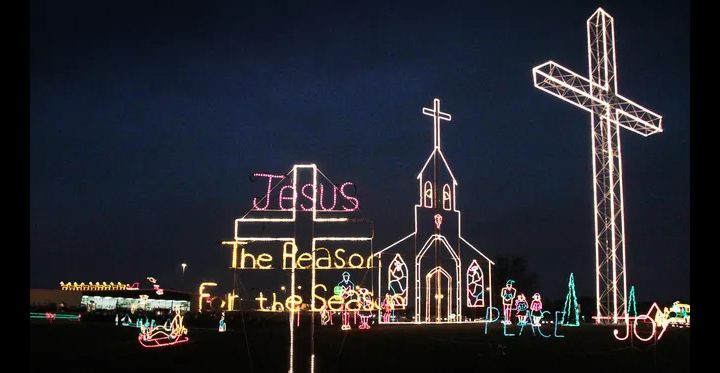As Christmas nears, one of my favorite things to do is look at Christmas lights. Nothing feels more festive than driving around that one neighborhood in town with the large historic homes decorated immaculately with twinkling lights and Christmas cheer.

Laura Ellis
Like interior decorations, people have different Christmas styles. Some go for the classic white light trim around their house and trees, and perhaps a tastefully small nativity scene, cluster of angels or family of deer. Others embrace fun with multicolored lights, inflatables and flashing red and green. I love it all, from simple to over the top and everything in between.
Everything that is, except for the crosses.
Amidst the twinkling lights, nativities and inflatables is the stray and inexplicable cross. It’s often made of Christmas lights so it can be seen at all hours. Sometimes it’s accompanied by the words “Jesus is the reason for the season.” In Texas, more than once I’ve seen a lighted image of a cowboy kneeling in front of a cross, holding his hat in his hand and the loose reins of his horse behind his back. Once, I even saw an inflatable cross with the star of Bethlehem at the top and a nativity image at the center.
“Think of how strange it would be if we decorated our yards and homes with nativity scenes at Easter.”
I’ve always thought decorating with crosses at Christmas was odd. For one thing, it’s simply the wrong Christian holiday. Think of how strange it would be if we decorated our yards and homes with nativity scenes at Easter. An image of Jesus’ birth would feel a bit out of place while contemplating and discussing his death and resurrection.
Life and death
Crosses at Christmas are not only out of place, but also a bit morbid.
As we consider the incarnate birth of Christ, it’s natural to ponder Mary’s pregnancy, the Holy Family’s journey to Bethlehem and Jesus as a crying, hungry, vulnerable baby. Yet, for some reason, in the middle of celebrating life — specifically the beginning of the life of Christ — we frequently see a symbol of his death. In a time of remembering this miraculous birth, a reminder of the tool of this baby’s death a few decades later is troubling.
The root of my problem with crosses at Christmas is deeper than a nagging little anachronism. This Advent season, let’s not kill Jesus before he even has a chance to be born.
When people decorate with crosses during Advent, I don’t think they mean to emphasize the death of Jesus at his first birthday. That’s incredibly dark. I think people display the cross because they believe the crucifixion is the most important part of the Christian story. People also decorate with them at Christmastime because the cross is the single most recognizable symbol of Christianity. However, this was not always the case.
The missing body of Christ
The symbol of the cross and other artistic depictions of the crucifixion did not appear in the early church until the 10th century. In their book Saving Paradise, Rebecca Ann Parker and Rita Nakashima Brock trace the historical popularization of the symbol of the cross, noticing that before the 10th century the most popular symbol of Christianity was paradise, not the crucifixion.
“Once he dies, that is all he seems to do.”
“It took Jesus a thousand years to die,” they write. “An image of Jesus dead does not appear in Europe until 960-970. Once he dies, that is all he seems to do.”
The popularity of depicting Jesus dead or dying on the cross spread infectiously and was most frequently used for political reasons. With the rise of the Christian empire came the rise of Christian-imposed violence, and “the first images of crucifixion emerge after Christian violence against pagans.” Brock and Parker claim this correlation is not coincidental.
Eventually, crucifixes and other depictions of Jesus’ suffering body declined in popularity until the cross alone became the predominant representation of Protestant Christianity. How strange it is that throughout history, we removed the body of Jesus and kept only the instrument of his murder as the symbol of our faith.
Beyond the 10th century, crosses and crucifixes continued to be wielded to gain political and social power in horrible instances of violence by the likes of crusaders and the Ku Klux Klan.
Lessons to be learned
Despite this complicated and sordid history, crosses and crucifixes also have been used as great symbols of hope and redemption, as well as nonviolent, everyday faith. Today and throughout history they have represented deep personal and collective devotion to God for millions of Christians and are the central focal point of most Christian churches.
“Emphasizing the cross specifically at Christmastime risks skipping ahead to the lessons of Holy Week without fully learning from the lessons of Advent.”
Regardless of its symbolic merits, I fear emphasizing the cross specifically at Christmastime risks skipping ahead to the lessons of Holy Week without fully learning from the lessons of Advent. Christians, and Baptists in particular, have a tendency to jump to Good Friday and Easter Sunday, no matter what season of the liturgical calendar we find ourselves in.
Holy Week does and should hold major influence on the make-up of our faith. But I often worry what we miss when we rush to crucifixion and resurrection. Diminishing Christianity solely to the death and resurrection of Jesus disregards the importance of the incarnate birth and life of Christ.
When we focus so much on the crucifixion, we can forget the lessons from the Sermon on the Mount. We forget Jesus did not spend time with religious leaders or in houses of worship, but with people society claimed were unclean troublemakers. We forget Jesus rejected violence and took time to rest. We forget Jesus honored, respected and listened to women. We forget Jesus’ life was not characterized by triumph or acclaim but by meekness and poverty.
When we jump to the violence and victory of the cross, we forget how Jesus lived his life. And we certainly forget the subtle and powerful miracle of his birth.
Christmas is my favorite time of the year, and not just for the lights, food and family. I love what this season can teach us spiritually. It’s more than just a sweet story with a journey, a donkey, an inn keeper, a manger, some shepherds and miscellaneous barn animals. It’s also about the miracle of incarnation — a word we Baptists don’t discuss much.
The wonder of incarnation
In the fourth century, St. Athanasius wrote On the Incarnation. It’s a beautiful, short piece that you could read in an afternoon or two, and Christmas is the perfect time to crack it open.
Athanasius was enthralled by the way God dwelled in a human body. He saw a miracle in the fact that Jesus walked on land as much as he recognized the miracle of Jesus walking on water because the simple fact that the divine was enfleshed is miraculous.
The incarnation demonstrates God’s intimacy and solidarity with the human experience. God “took to himself a body, a human body even as our own … He could have revealed his divine majesty in some other and better way (but) he took our body.”
Athanasius claimed humanity is redeemed through the solidarity between the body of Christ and the bodies of individual people. Through God’s indwelling in Jesus’ human body and in all of humanity, people are returned to the image of God within themselves and to the image of God in the people around them.
The incarnation demonstrates there’s importance in the fact that we are not just floating bodiless souls but embodied spiritual beings. In other words, our bodies, what happens to them and how we use them, matters. We were created to connect with God and each other with and through our bodies.
There is so much to celebrate, to ponder and to learn from the miracle of incarnation — from the miraculous truth that God chose a human body as a home, to what that means for our salvation, to how that influences the way we connect to God and to one another.
So this Christmas, let’s put away the crosses, because Advent offers plenty of rich spiritual lessons all on its own.
Holy Week will come soon enough. The inevitability of Good Friday and Easter Sunday is just around the corner. But before we pull out the red and green crosses and rush to the drama of crucifixion, let’s lean into the less cinematic but perhaps more miraculous truth of this season of incarnation.
Laura Ellis serves as project manager for Baptist Women in Ministry. She is a former Clemons Fellow with BNG and previously served in ministry with Safe Havens Interfaith Partnership against Domestic Violence and Elder Abuse. She lives in Waco, Texas, and earned a master of divinity degree from Boston University School of Theology.
Related articles:
Salvation as deliverance and blessing: Moving from Thanksgiving through Advent to Christmas | Opinion by Stephen Shoemaker
Merry Christmas from Paul the apostle in prison | Opinion by Jenna Sullivan


